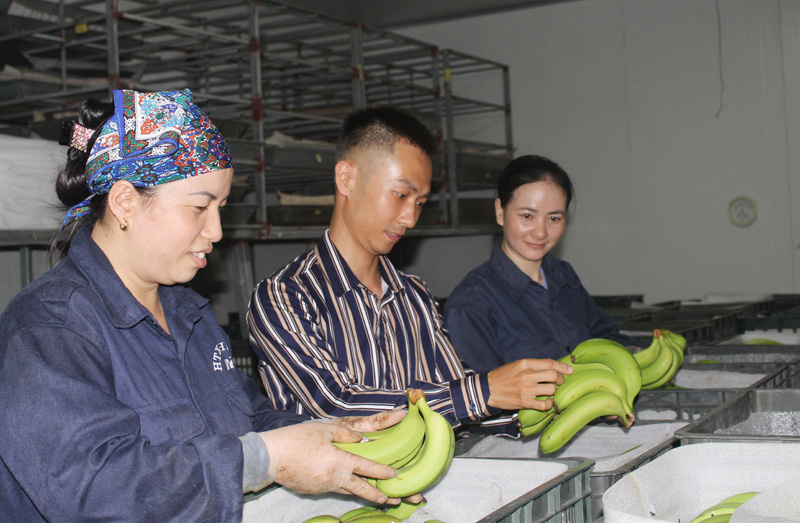
(HBO) - With a hope to introduce Hoa Binh province’s agricultural products to the world, Banana Viba Cooperative in Lien Son commune, Luong Son district, has carried out closed processing from production to distribution following VietGAP standards, with a focus on building the "Banana Viba” brand.
Banana Viba was recognised as a three-star OCOP product by the provincial People’s Committee.
In 2019, Banana Viba was recognised as a three-star OCOP product by the provincial People’s Committee. The cooperative sells an average of around 1,000 tonnes of banana, earning over 10 billion VND a year.
Tran Trung Duc,
Chairman and Manager of the cooperative, said that the cooperative’s total area
of banana is over 25ha, of which 9.5ha are grown following VietGAP standards.
The material area of the cooperative has expanded to Kim Boi district, Hoa Binh
city and Hanoi. The cooperative has provided support in variety, capital,
technical issues and product distribution for its members. The members, in
turn, have to strictly obey production process.
The cooperative installs
automatic sprinkler systems and covers the growing area with nylon membrane. It
also invested in building a 1,000sq.m semi-processing factory. All purchased
products are semi-processed, classified and marked with traceability stamps.
The cooperative has
three rooms to ripen bananas with high technology with a maximum capacity of 5
tonnes a day. Bananas ripen naturally thanks to absolutely safe bio ethylene.
As the fruit is ripened at a temperature of around 20 degrees Celsius, all
vitamins and minerals are kept, and it has a bright colour and can be stored
for five days.
The Banana Viba
Cooperative also invested in building an incubator with a total area of
2,000sq.m to nurture strong young trees to proactively serve production.
With high quality and
bright skin, Viba banana has affirmed its prestige to consumers. At present,
the cooperative has over 1,000 partners nationwide, including such major
supermarkets as Vinmart and BigC. In the first half of 2020, it sold more than
600 tonnes of banana, earning 6 billion USD. Per capita income reached over 10
million VND per month.
The cooperative also generates jobs for 10 labourers
with a monthly salary of 5 million VND per person. Especially, in 2019, the
cooperative signed a contract to serve 2 quintals of banana a day on flights of
the national flag carrier Vietnam Airlines. This is a great opportunity for
this kind of fruit to reach the world./.
According to data from the Hoa Binh Provincial Party Committee, the industrial production index for the first six months of 2025 is estimated to have increased by 20% compared to the same period last year. This marks the highest year-on-year growth rate for this period since 2020.
In the first six months of 2025, Hoa Binh province’s export turnover was estimated at 1.145 billion USD, marking an 18.11% increase compared to the same period in 2024. Import turnover was estimated at $ 804 million, a 17.15% increase, which helped the province maintain a positive trade balance.
The lives of the ethnic minority farmers in Tan Lac district have gradually improved thanks to the new directions in agricultural production. This is a testament to the collective strength fostered through the professional associations and groups implemented by various levels of the district’s Farmers’ Union.
With the motto the "product quality comes first,” after nearly one year of establishment and operation, Muong village’s Clean Food Agricultural and Commercial Cooperative, located in Cau Hamlet, Hung Son Commune (Kim Boi district), has launched reputable, high-quality agricultural products to the market that are well-received by consumers. The products such as Muong village’s pork sausage, salt-cured chicken, and salt-cured pork hocks have gradually carved out a place in the market and they are on the path to obtaining the OCOP certification.
In the past, the phrase "bumper harvest, rock-bottom prices" was a familiar refrain for Vietnamese farmers engaged in fragmented, small-scale agriculture. But today, a new spirit is emerging across rural areas of Hoa Binh province - one of collaboration, organisation, and collective economic models that provide a stable foundation for production.
Maintaining growing area codes and packing facility codes in accordance with regulations is a mandatory requirement for agricultural products to be eligible for export. Recently, the Department of Agriculture and Environment of Hoa Binh province has intensified technical supervision of designated farming areas and packing facilities to safeguard the "green passport" that enables its products to access international markets.



